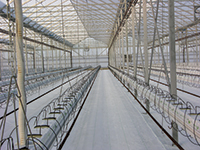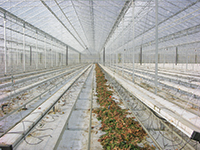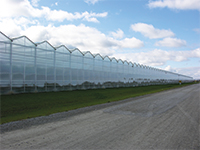
Features
Crop Culture
Inputs
Greenhouse Grower Notes: October 2011
September 28, 2011 By Gillian Ferguson
Devoting more time this fall to cleaning things up will mean less pest and disease pressure next year.

|
|
| A clean greenhouse following the sanitation and disinfection process.
|
We are fast approaching the end of 2011’s production season and it’s time to think about preparing for 2012. As always, the type of cleanup achieved at the end of this season will likely serve as a predictor for next year’s pest and disease problems. The good thing about cleanup time is that it gives us an opportunity for a fresh start. To do a really good job, though, we need to remember key principles based on the biology of our key pests as they relate to their survival and possible carryover to the next season. As such, I have included some reminders here for consideration.
Insect and mites – Most of the pests that attack greenhouse crops can survive in the greenhouse between crops during the winter period, particularly if infested debris is left in the house. The fact that temperatures may not even reach the freezing point because of the buffering effect of the structure means that even those pests that don’t have a specific overwintering stage – e.g., spider mites – can survive.
Instead, we need to take advantage of the higher metabolic rate and activity of insects at higher temperatures. We do this by maintaining a warm greenhouse during the
cleanup phase to render them more vulnerable to controls applied. We have much more to gain in reducing pest populations by combining warmth with dry conditions, versus attempting to freeze them out. An example of the effects of temperature on insects is provided by western flower thrips.
Western flower thrips and temperature effects: Sanitation trials done at the Greenhouse and Processing Crops Research Centre in Harrow, Ontario, by Dr. Les Shipp capitalized on the principle of temperature effects, combined with a dry environment.

|
|
| Crop debris ready for removal.
|
WARM AND DRY CONDITIONS HELP WITH CONTROL MEASURES
He found that maintaining a temperature of 40ºC with a vapour pressure deficit of 4.76 kPa for three days resulted in 100 per cent reduction of adult and immature thrips. This time is likely necessary because of the all-important pupal stage of this pest.
Pupae are quiescent, non-feeding, mostly on the ground, and likely, often under the floor cover, and therefore, well hidden. Warm temperatures are needed to promote the transition from pupa to adult stage, when it is much more susceptible to cleanup procedures. The time taken for completion of the pupal stages is three days at 30ºC, about five days at 20ºC, and 8.5 days at 15ºC.
Diseases – This category includes all fungal diseases, bacterial diseases, especially bacterial canker, and virus diseases in general. The essential aspect, and the threat, of most diseases is that plant tissue (including stems, leaves and roots) can harbour spores, viruses and other disease-causing stages, and most importantly, can provide protection from disinfectants.
For example, trials done by now retired Dr. Mike Tu at the Greenhouse and Processing Crops Research Centre in Harrow, demonstrated that canker-causing bacteria survived in tomato debris infected with bacterial canker, even after high concentrations of a disinfectant were applied to the tissue. This trial showed that mere application of a disinfectant to the surfaces of diseased tissue cannot kill bacteria, viruses, spores and other fungal stages that are embedded, and therefore protected, within plant tissue.

|
|
| A weed-free perimeter.
|
IMPORTANCE OF COMPLETE REMOVAL OF CROP DEBRIS
The key lesson here is that the only way to prevent, or at least minimize, carryover of sources of disease is to, first of all, remove as much debris as possible, if not all of it. Subsequent proper washing and disinfection of greenhouse structure and contents go without saying.
Weed control – Removing all weeds from the greenhouse is essential because many of our common pests can over-winter on these plants. Prime examples are thrips, aphids and whiteflies.
Although the greenhouse whitefly has no stage specially adapted for hibernation, its egg stage is highly tolerant to low temperatures. Whitefly eggs can survive up to 15 days at -3ºC, and as many as five days at -6ºC. As long as cold-tolerant green plant material exists in the greenhouse, the greenhouse whitefly has a good chance of surviving relatively cold conditions via the egg stage. This applies equally to a range of other pests.
Weed control is important within the greenhouse, and equally so outdoors, particularly in the immediate surroundings of the greenhouse.
Weeds harbour not only insect and mite pests, but many diseases as well. Weeds are best controlled in the fall rather than in the spring when weed control measures can force flying pests to seek food and shelter in the land of plenty in our greenhouses.
In conclusion, if sufficient time, effort and energy are given to the cleanup process, next year’s management of pests could be so much easier! ■
Gillian Ferguson is the greenhouse vegetable IPM specialist with the Ontario Ministry of Agriculture, Food & Rural Affairs. • Gillian.ferguson@ontario.ca
Print this page